One of the most spirited debates in the conservation world is Birds vs Fish. Until recently the bird-nerds and the fish-heads coexisted peacefully, respecting each other’s shared conservation ethic and passion for their respective corners of the natural world. But then a rousing Twitter debate pitted the anglers and ichthyologists against the birders and ornithologists… and things got ugly.
I’m firmly on Team Bird. When I’m outside my binoculars are always to hand, and I’ve been known to wander off from conversations mid-sentence to look for whatever just flew by. Despite a deep love of water and a lifetime spent puttering about in all sorts of watercraft, I can only recall three times in my life where I’ve gone fishing:
Age 6: My brother and I used hotdogs to catch little fish from the edge of our dock, an endeavor that ended in us arguing over whose fish was bigger and whacking each other with our rods. (Mine was bigger.)
Age 13: I was quite skilled at catching small bass, minnows, crawfish, and turtles using a net on the end of a long pole. My deepest desire was to be Steve Irwin, so I’d narrate my “fishing” adventures to an invisible camera in a truly abysmal Australian accent, dressed up in khakis and an akubra hat straight out of the Crocodile Dundee movie.
Age 28: I was staying at a tiny island research station in the Solomon Islands, and we had to hand-line for our dinner every evening. On the first night a 4-foot-long Spanish mackerel hit the bait so hard that it nearly pulled me out of the boat. My gloves (and hands) were shredded, but the fish was delicious.
None of these prior experiences were enough to truly understand why some people — including my co-workers and friends — feel the draw of fins more than feathers. So I set out on a mission to learn how to fish. And because I’m a writer with absolutely zero shame, I’ll happily exploit myself for your amusement.
After all, how hard could it be?
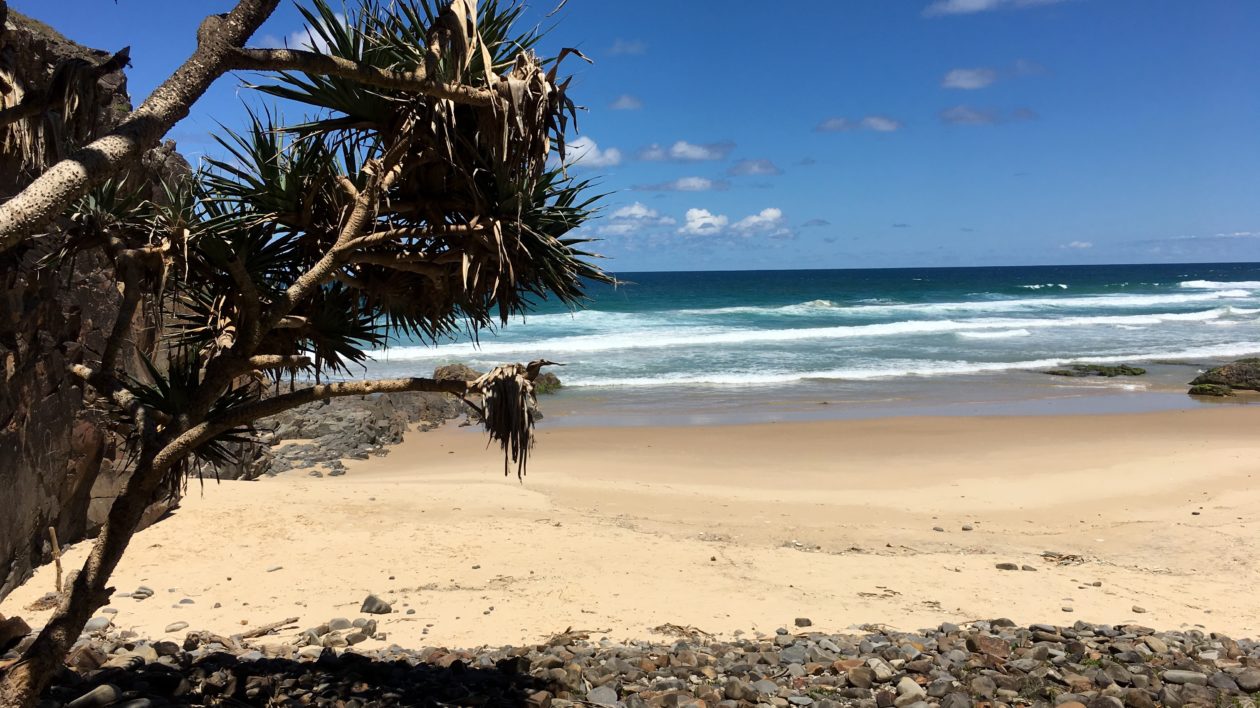
Fishing Attempt #1: Noosa National Park, Queensland, Australia
Even I know that you need bait to catch a fish, but it turns out that acquiring it is not as simple as stopping by the local We’ve Got Worms! bait shop.
Instead, I’m standing ankle-deep in the Sunshine Coast surf, squatting and vigorously wiggling my hips from side to side. I look like an absolute idiot, but with each wiggle my toes uncover another pippie clam hidden in the sand. Thankfully I’ve done this before, otherwise I’d assume that my friend and fishing mentor for the day, Troy, was having a good laugh at my expense.
Our bait bucket rattling with clams, we hike up a ridge into the national park and then down through some pandanus trees to a little beach tucked between two cliffs. I’m ready to get after the fish, but Troy tells me that the clams are just the bait… for the bait. Seriously?
Apparently, our real targets are the meter-long, pink worms lurking in the sand. Troy begins an elaborate routine of chumming the water with a chunk of rancid fishmeat (held between his toes), rubbing smooshed clams over the sand to coax the worms out, and then pouncing on them at exactly the right moment. If just catching the bait requires this combination of skill and outright magic, how the heck am I ever going to catch a fish?
Eight worms later (none of them mine) we finally we get to fishing. Troy nips of a few centimeters of worm, threads it onto the hook, and casts lazily into the surf. Reel, wait. Reel, wait. Within a minute there’s a tug on the line, and then a plump whiting is whizzing towards us through the waves.
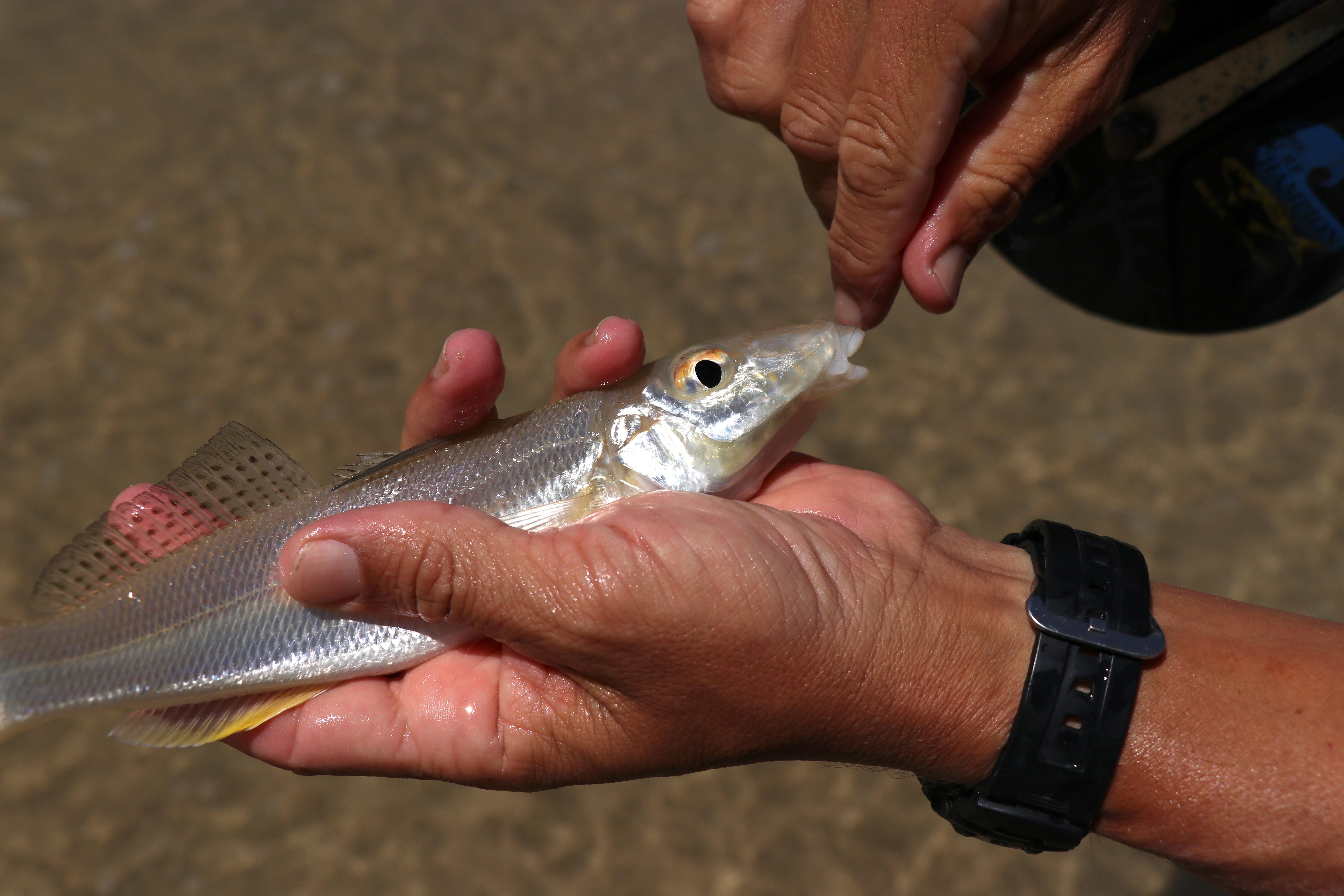
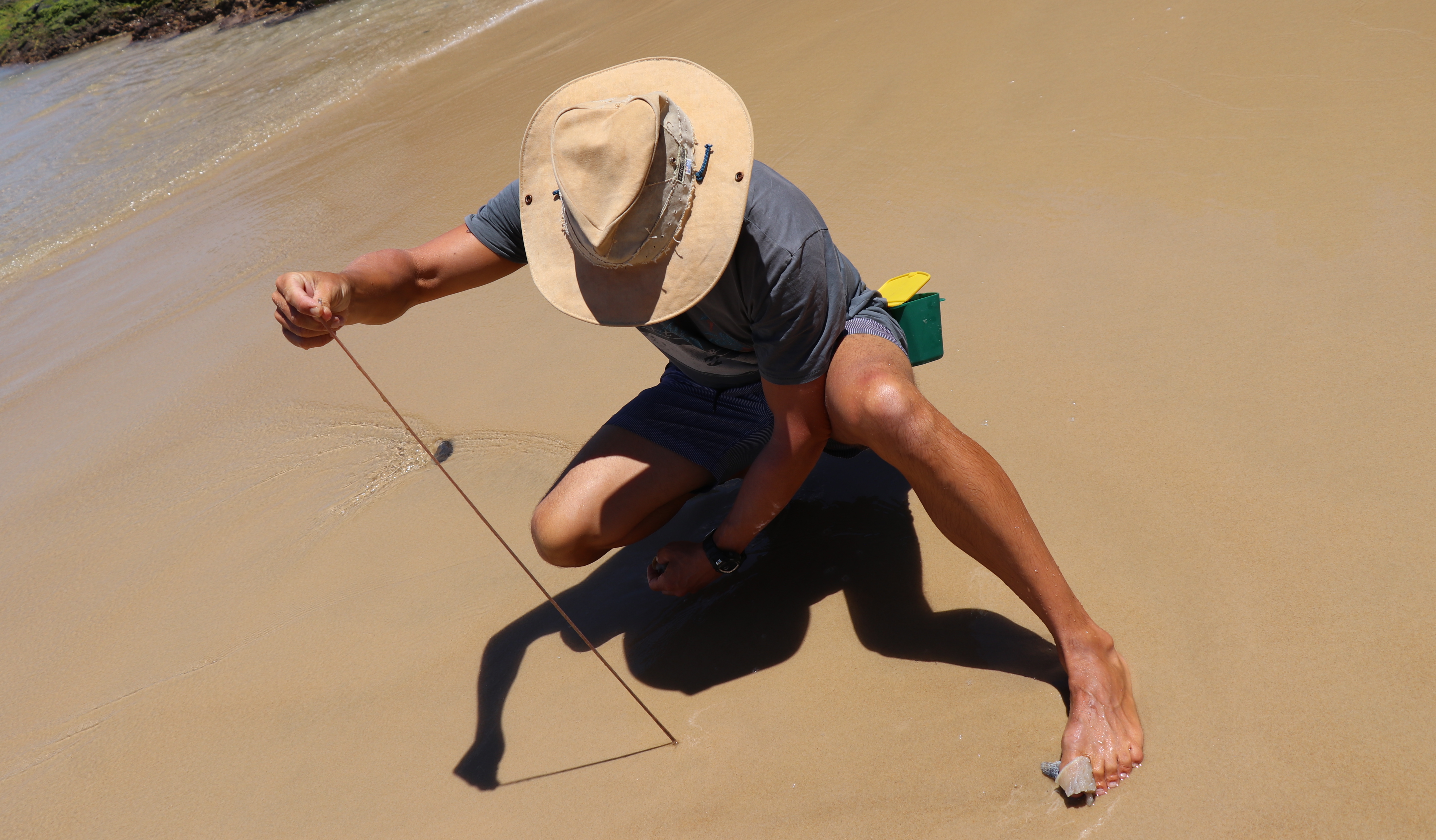
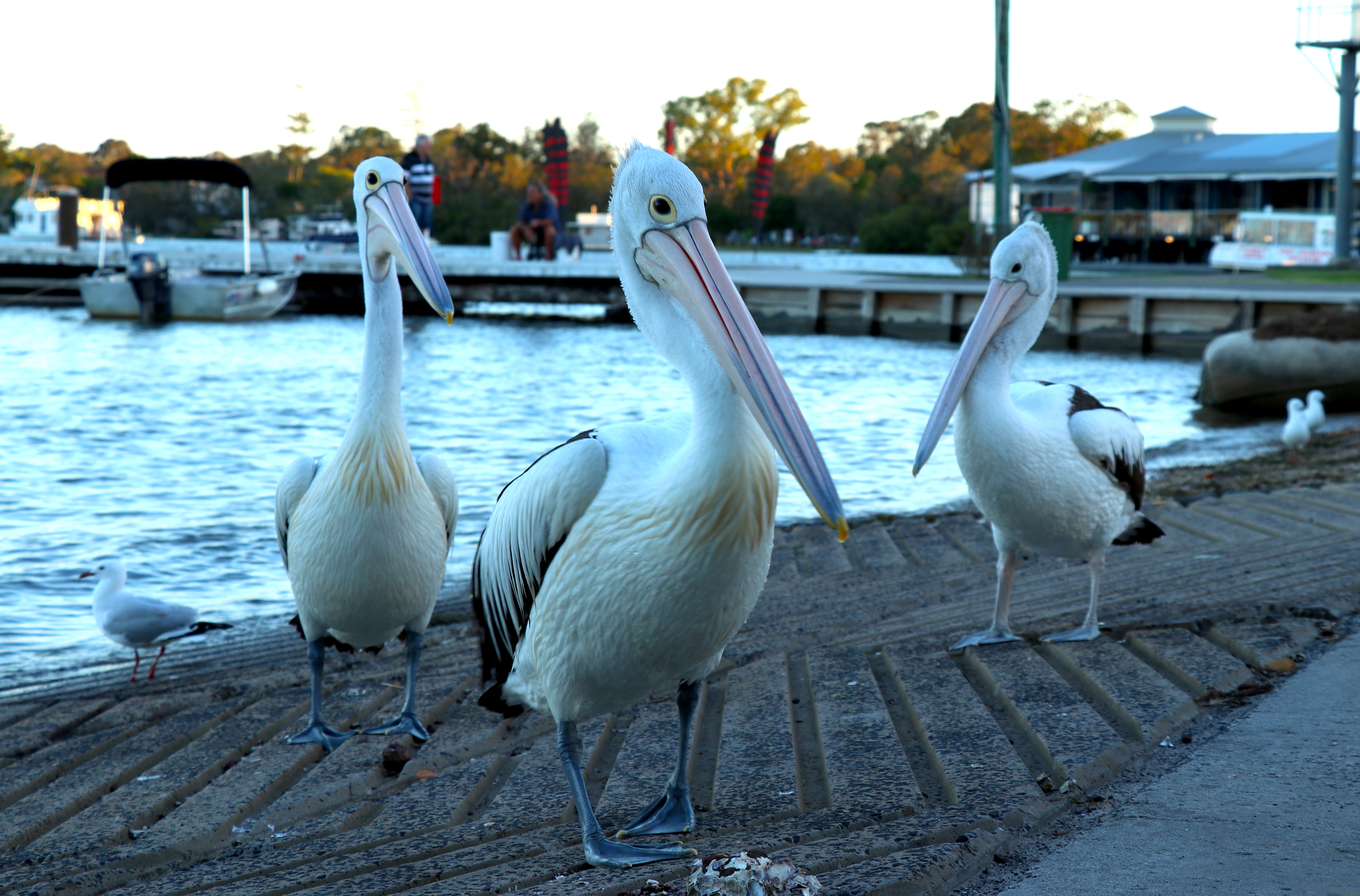
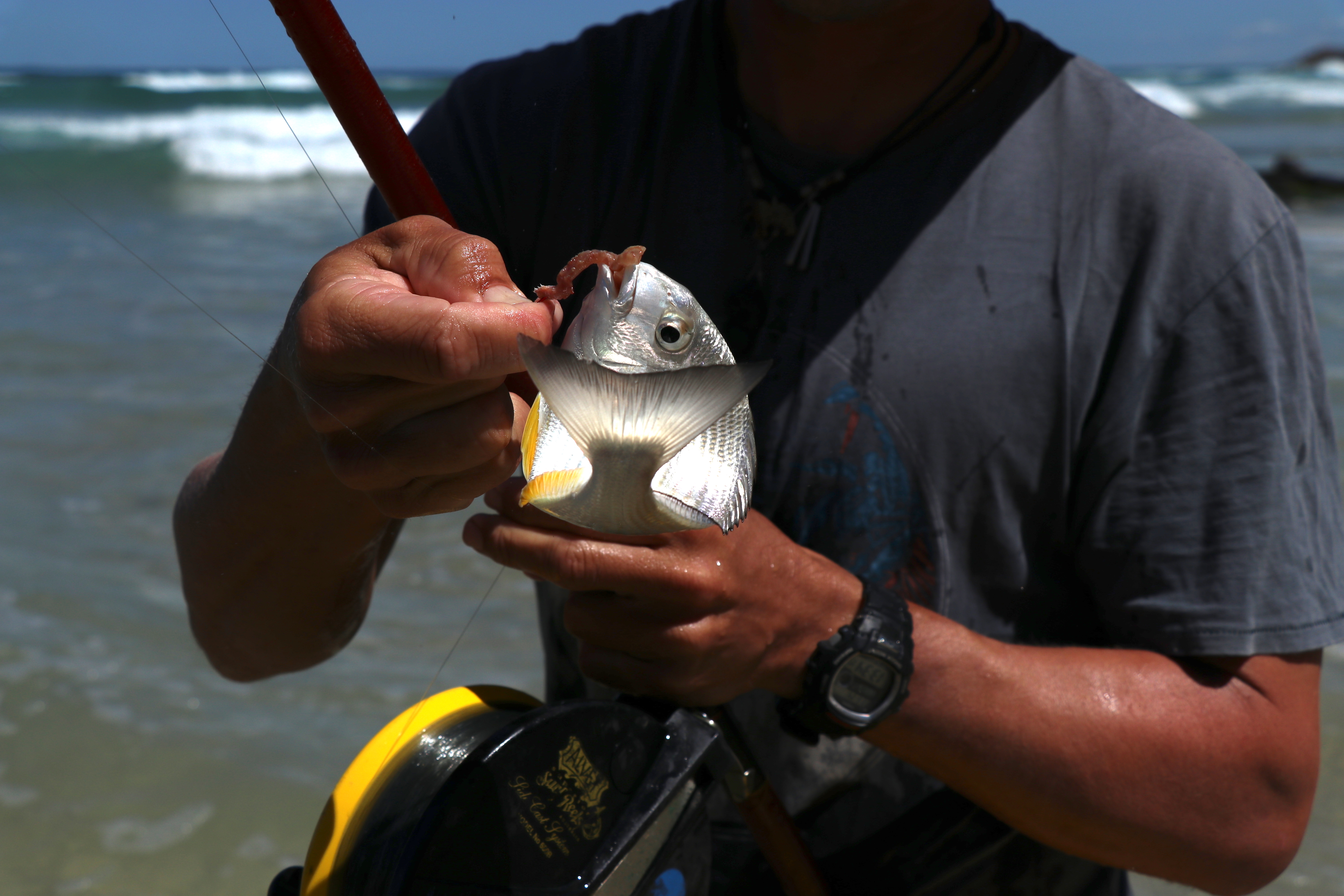
Meanwhile, I’m grinning like an idiot and resisting the urge to jump up and down. We just caught a fish! From the water! It all seems delightfully straightforward: bait the hook, chuck it out, wait 5 minutes and BOOM, you have a fish. The sun is warm, the beer is cold, I have worm guts under my nails… okay, this is fun.
Another cast, and Troy hands me the rod and turns back to deposit our fish in the cooler, amid the beers. All I have to do is stand here and hold this big stick? Surely I can manage this one, simple task.
Nope.
Within 5 seconds I manage to detach the reel from the rod and narrowly avoid dropping it into the surf. Help? But Troy is halfway up the beach and I’m on my own. I back out of the surf slowly, cradling the reel against my stomach and trying to keep the line taught and untangled. I’ve nearly made it back to the beach by the time Troy comes to rescue me, trying his best not to laugh.
The next cast yields a second fish — I redeem myself somewhat by reeling it in without problems — and then a third and a fourth. It’s immensely satisfying, like playing a slot machine and winning every time, only instead of cash the prize is a wriggling, slimy fish.
Fish number five is too small to keep, but its swallowed the hook and won’t make it off the line alive. Right on cue, a shadow glides along the shore. It’s a brahminy kite, stalking us for an easy meal. Sensing my interest reverting instinctively back to birds, Troy tosses the whiting up the beach and tells me to wait.
The kite circles, nervous. He eyes our offering, and then us. We back up a few meters. I can barely contain my excitement, because birds. Another beady look at us, and back at the fish. Finally he dives down, snatching the whiting and high-tailing it the heck away from us.
If I can feed the occasional raptor, then I’m officially in love with fishing.
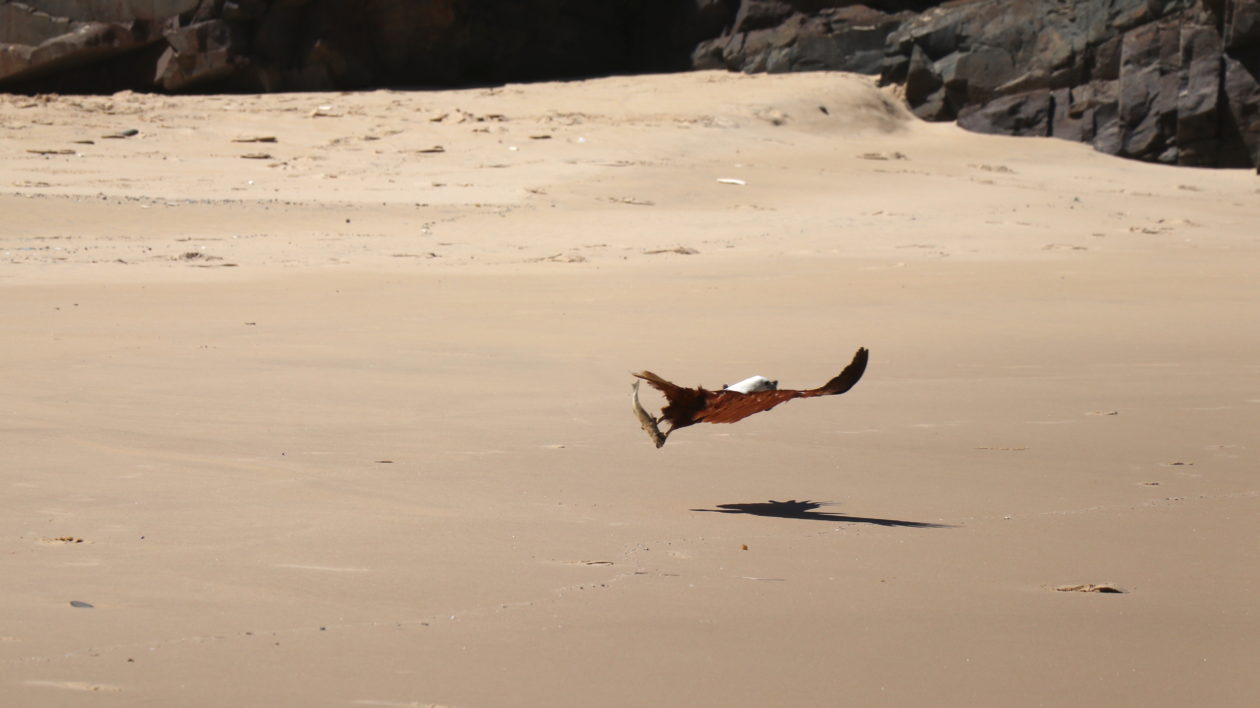
Several beers and a nap later, it’s time to head home. We hike back out and drive to one of the many fish-cleaning stations along the Noosa River. This needs no explanation… stinky dead animals are best disemboweled outside of your house.
But the fun isn’t over yet: Lined up on the boat ramp are three massive Australian white pelicans and a mob of raucous silver gulls, all eyeing us greedily.
Troy gives up on me and lets me snap away with my camera as he cleans the fish, chucking scales and entrails to the gathering crowd. The gulls screech and squabble and posture comically with their wings, each defending its square-inch of turf. The pelicans are keen for a snack but clearly used to handouts, because they don’t even bother unless we chuck the fish straight into their open pouches. Before long the last fish is filleted, all the scraps are gobbled down, and it’s time to head home for some fish and chips.
Species Caught
Fish Eaten
Skills Learned
Bird Distractions
Contentment Factor
Conclusion
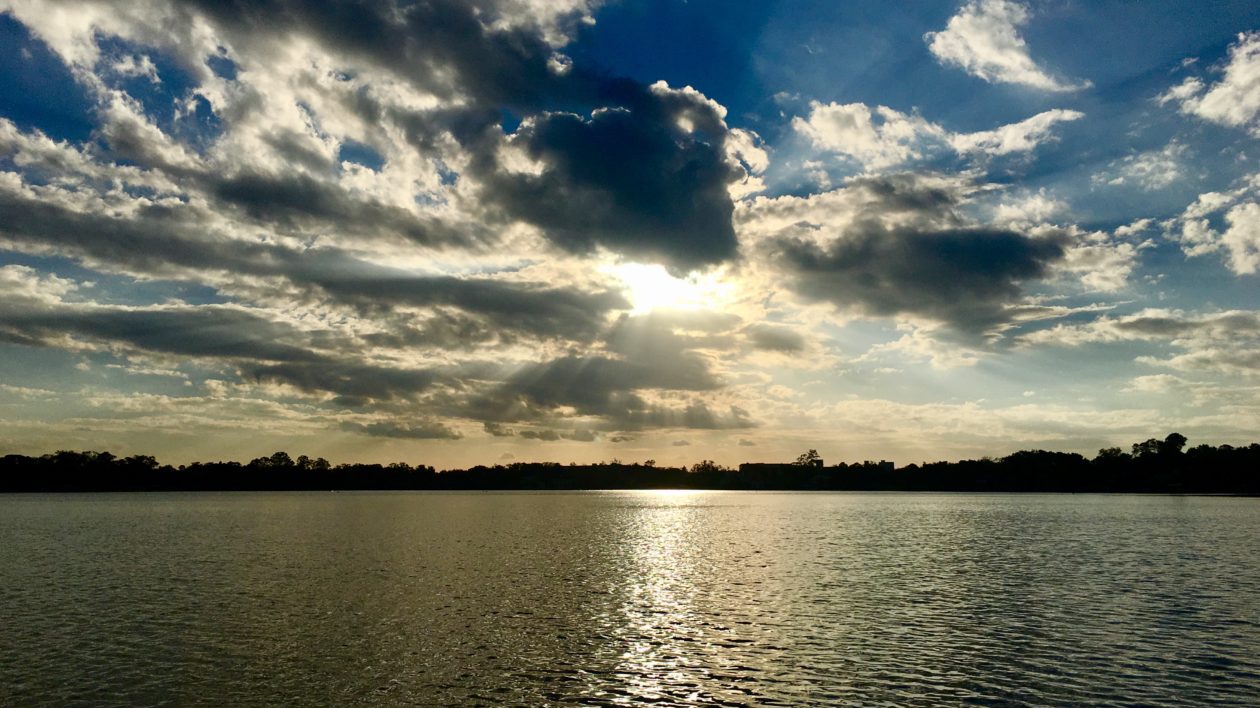
Fishing Attempt #2: Lake Minnehaha, Florida, USA
Two months later, I’m home in Florida for the holidays and desperately in need of a way to escape my family. I already kayak at least once a day, so why not add a rod and reel and see what happens? It seemed easy enough in Australia (flawed assumption #1), and if I managed it when I was 6 years old how hard can it be (flawed assumption #2)?
Given that I’m on my own this time, I ask my fishing-guru boss, Matt Miller, for his recommendations on the best possible rod for the least amount of money. One trip to Walmart later and I’m unwrapping a $25 Ugly Stix, complete with a little box of wiggling, glittery, fluffy, colorful plastic things.
The line is already on the spool, but everything else was up to me. Being reasonably intelligent (and stubborn), I figure I can do this myself. Wrong. Twenty minutes later everything looks perfect, except it isn’t reeling in properly.
So I turn to Youtube, which is immensely unhelpful because all of the fishing-for-dummies videos out there assume that any dummy can at least rig the rod properly. Twenty more minutes of swearing later, I realize that the line needs to go on the other side of the flippy thing, which I learn is called a bail.
Naively assuming my frustrations are over, I grab three hot dogs and a bucket, fashion an anchor for the canoe out of some molding rope and an old gym weight, and shove off the dock.
I anchor 30 meters out and set about learning to cast. Here the Youtube videos do help, and I after a few minutes I actually get the hang of it. Cast, reel, cast, reel. Okay, now I want my fish. I hook on a piece of the supermarket’s cheapest pork-and-cheese hotdog and cast again. Nothing much happens, but I’m barefoot in a boat and once again quite content.
After a few minutes, I hear a gurgling hiss and whip around, nearly upsetting the canoe. Our local otter just popped his head above the waves and is growling furiously at me. He dives down and then re-emerges even closer, clearly wondering what sort of jerk splashes about as he searches for supper. After watching me for a full minute — growling all the while — he swims back towards shore, leaving a bubble-trail in his wake.
The fish are thoroughly frightened so I paddle in for the night, confident that tomorrow will bring my first fish. Wrong again.
The next morning our neighbor wanders over to make sure I’m not doing anything stupid. He gives my rod a surprised nod of approval, and then recommends I make dough balls for bait. So back to the internet I go, and before long I’m boiling a revolting concoction of flour, eggs and tuna.
Apparently the fish also find it revolting, because two hours go by without even a single curious nibble. Then some locals cruise by in a speedboat, kitted out in fancy gear and catching fish after fish right in front of me. By this point I’m absolutely murderous — and out of beer — so I decide to give it one more cast and then head in.
A fat bass literally jumps over my line. I hate everything.
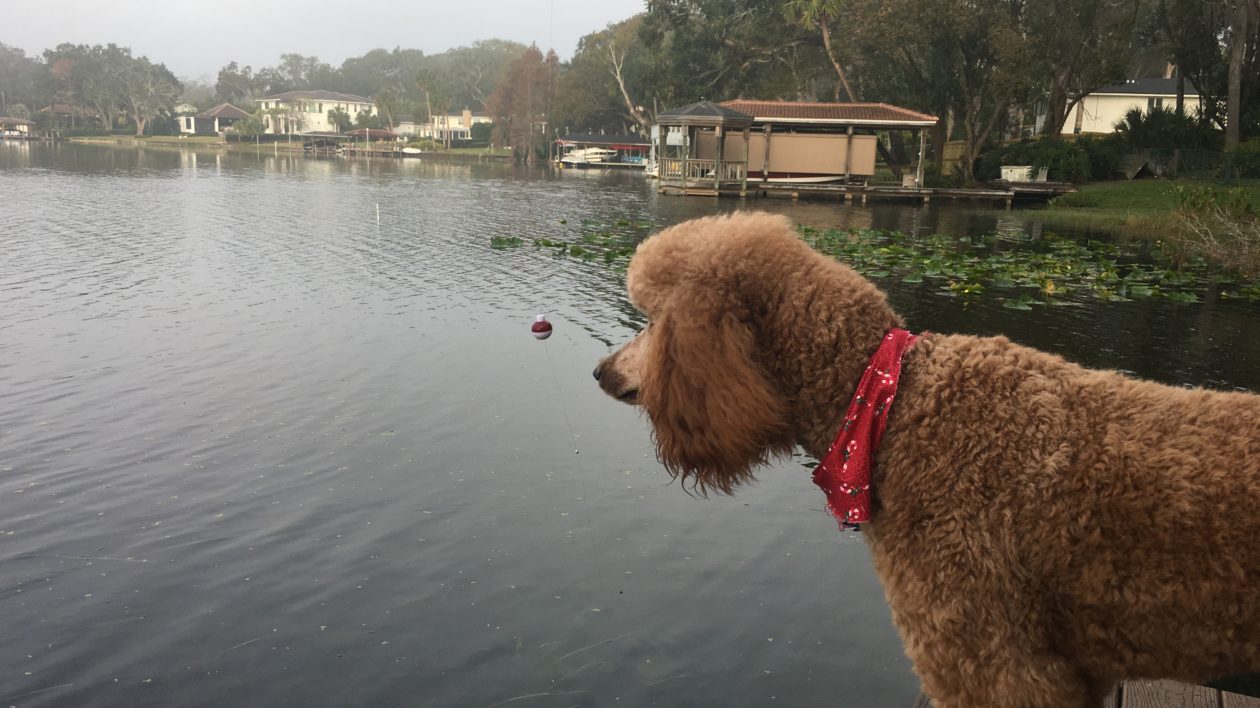
Windy weather keeps me indoors for a few days, and I use the time to further delude myself that I’ll definitely catch something next time. To the delight of our family poodles, my casting improves enough that I can fish from the dock. Each time I reel in, the puppy has a complete meltdown about the mysterious (and possibly threatening) object moving towards him in the water and then tries to bite the bobber.
Another hour. No fish. And then another, still no fish. Behind me I hear a bark — the old dog is staring intently into the bucket I left in the canoe days ago, in the hopes of showing off my first catch. Another woof, this time more concerned. I put my rod down, walk over, and peer into the canoe. There’s a massive dead mullet floating belly up in the bucket, and my father is laughing his head off from the back window.
Once again, I hate everything.
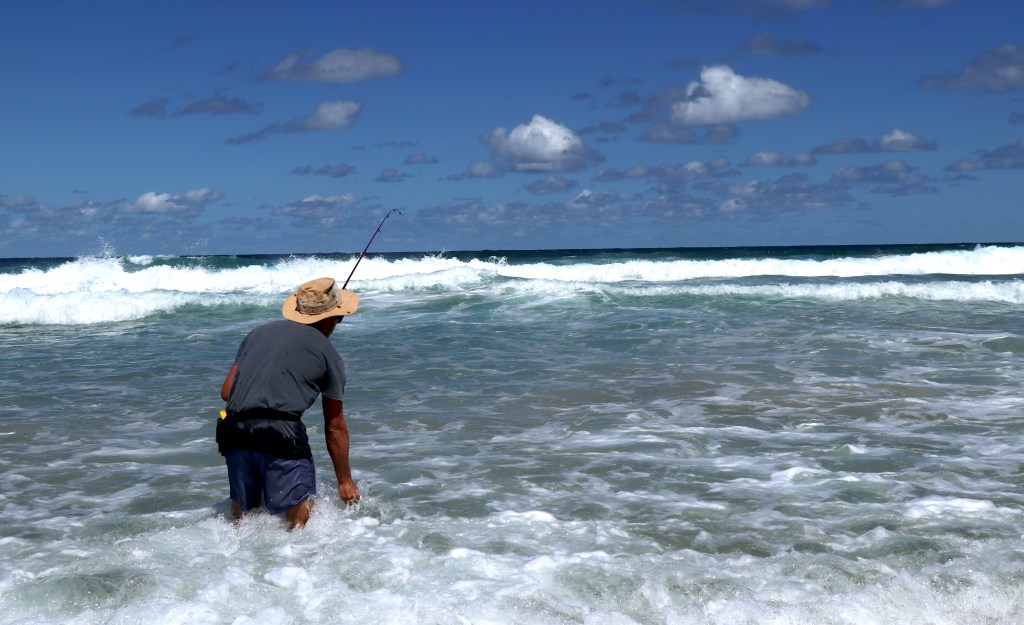



Just loved it!
“A fat bass literally jumps over my line. I hate everything.” — my new email signature line!
People who genuinely appreciate birds or fishes, or any other animals, don’t cause them needless harm. Just as birders wouldn’t torture birds for ‘fun,’ we shouldn’t needlessly cause harm to fishes. Science has shown that they, too, are sentient beings who suffer fear and pain: http://fishfeel.org/fish-sentience/ Many who are caught and released also perish due to the injury and trauma they’ve suffered.
All of the nutrients derived from fish (and other animals) can be obtained more healthfully, humanely, and environmentally responsibly from plant sources. The Nature Conservancy should be promoting respect for animals, not encouraging people to torture them.
You nailed it.
“Doing the same thing over and over and expecting different results isn’t the definition of insanity… it’s fishing.”
And crazy people, like me, enjoy every second of it as well as bird watching while fishing.
Great story! You should include halibut fishing up here in Kodiak Alaska… 🙂 THEN you would have a REALLY FUNNY story to write about! 🙂 Wendy (Kodiaks Wild Side!)
Please tell me you took the hook out of the small fish before feeding it to the Kite. And please tell me you did not feed fish bones to pelicans – that tears their pouches. Here are some links to share to educate people about these issues:
http://www.keepthemflying.org/feedingpelicans/
“Pelicans have evolved to hunt and consume small, soft-bodied bait fish, and they are not equipped to digest large bony fish. This can create several problems for pelicans that attempt to consume larger fish that they wouldn’t normally eat. This includes filleted fish that are tossed to them. The sharp, pointy bones of larger fish carcasses can pierce the soft tissues of pelican pouches, throats, and stomachs. This can lead to several unfavorable situations. Puncture wounds in a pelican’s pouch can make hunting difficult, and lead to infections later on. Fish carcasses can also become lodged in the throats of pelicans, causing internal bleeding and making the ingestion of normal food nearly impossible by blocking the path to the bird’s stomach. This can lead to malnutrition and eventually starvation. Much like the throat, bony fish carcasses can also cause puncture wounds and internal bleeding in the stomach, but an even larger problem can also arise. The acid in the stomachs of pelicans isn’t strong enough to break down the bones of bony fish, and the bones can end up remaining in the bird’s digestive system indefinitely. These bones can be a breeding ground for bacteria and other pathogens that can make pelicans ill while also inhibiting the normal digestive process.”
Hi Jennifer, thanks for reading and for your message. Yes, we did remove the hook from the fish we tossed to the kite, and we were careful to only toss skin and other soft parts to the birds. Thanks – Justine